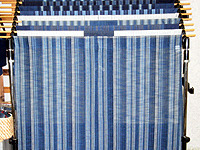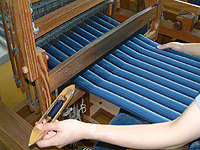

Total:131items
- Pottery & Porcelain (18)
- Lacquerware (4)
- Glasswork (2)
- Wood & Bamboo Work (19)
- Leather Work (1)
- Papermaking (13)
- Textile (20)
- Touzan-Ori: Touzan Weaving
- Sakai Gogatsu Koinobori: Sakai May Carp Streamer
- Nanbu Sakiori
- Nihon Shishu: Japanese Embroidery
- Tsuzurenishiki-Ori: Tsuzurenishiki Weaving
- Ojiya-Tsumugi: Ojiya Pongee
- Ise-Momen: Ise Cotton
- Ojiya-chijimi: Ojiya Crepe
- Yanai-jima: Yanai Stripes
- Kogin-zashi: Kogin embroidery
- Tamba Momen: Tamba Cotton
- Awa Shijira-ori: Awa Shijira Weaving
- Saga Nishiki: Saga Brocade
- Shinshu-Tsumugi: Shinshu-Pongee
- Kyo-nui: Kyoto Embroidery
- Noto Jofu: Noto-jofu hemp fabric
- Matsusaka Momen: Matsusaka Cotton
- Murayama Oshima Tsumugi
- Nibutani-attus
- Oku-Aizu Showa Karamushi Ori: Oku-Aizu Showa Ramie Textiles
- Dyeing products (5)
- Masonry (1)
- Metal Work (11)
- Stationery (4)
- Livingware (3)
- Accessory (4)
- Toys & Entertainment (14)
- Interior (2)
- Other crafts (10)

 |
Main Production Site:Mie |
 《Characteristics》
《Characteristics》Matsusaka momen (cotton) is woven with indigo-dyed thread that is rich in earthy scent, and has a wide variety of striped design patterns. In the Edo Period (17-19c), with its sumptuary laws that restricted luxurious fashion items, this cotton was highly appreciated as the most fashionable kimono fabric available to the Edo citizens, who took their pride in their "iki".*
*"Iki" is a traditional Japanese sense of style, which roughly means "chic", or sophisticated stylishness.
Matsusaka momen looks like subdued solid fabric from a distance, but when you get a closer look, you will notice that it actually consists of delicate but clean vertical stripes. This subtle design was perfect for the sensitivity of "iki", and made Matsusaka momen very popular. In fact, it was so popular that the average annual sales of Matsusaka momen was more than 500,000 units in Edo (present day Tokyo), where the entire population was about one million. To this day, when a Kabuki actor dons a striped kimono, it is referred to as "wearing a Matsusaka". This is an impressive testimonial of Matsusaka momen's continued popularity.
Matusaka momen is designated as a traditional craft of Mie Prefecture (Western Japan). In addition, the weaving techniques and custom associated with Matusaka momen have been recognized as intangible folk cultural properties of Japan.
[Mie Prefecture designated traditional craft]
Information provided by: Matsusaka Cotton Hand Weaving Center
Translation by: Misa Imanaka, reviewed by Marina Izumi

| Materials | Indigo-dyed thread |
|---|---|
| Crafting Processes | [1] Reeling the warp threads
The warp thread color is decided, and only what will be used is reeled to a wooden frame. [2] Warping the loom Set the reeled warp on the loom to prepare the threads of the necessary length. [3] Creating the striped warp The reeled warp threads are re-ordered by color. [4] Pre sleying the reed "Araosa toshi" or the process of threading reed dents, or teeth, decides the fabric width. In the order of the color of the pattern, four threads are passed through each dent of the reed. [5] Beaming the warp "Chikiri" is the warp beam to which threads are reeled to. As the warp threads are held tightly across the loom, any frayed thread is repaired and reeled to the beam. [6] Removing the reed The reed between the two lease sticks are removed. [7] Threading the heddle "Soko", or a beater, is the part of the loom that moves up and down. The beater houses 880 wires, or heddle each with a hole in the middle. Each of these wires is threaded one by one. [8] Sleying the reed Threads passed through the heddles are threaded through the reed, two threads per dent. [9] Weaving The shuttle, called "Hih" weaves the cross threads through the warp. |
| History | In the late 5th century, the descendants of "Kurehatori", or weavers who travelled from China, spread the spinning and weaving techniques mainly to "Hatadono (the place for weaving)" in the eastern city of Matsusaka where fabrics are still woven for Ise Grand Shrine today. In the Muromachi period (14-16c), cotton farming spread and cotton weaving thrived.
Warm and durable cotton was praised as "godly assets of the earth" and contributed to a clothing revolution. Cotton from Matsusaka became widespread by the hands of Ise traders who expanded to the Edo markets rather early. Records indicate Matsusaka sent out over five hundred thousand units of fabric year after year. Its distinctive woven stripes are said to be an adaptation of the striped Vietnamese "Jyoryufu" fabric, which was brought to Matsusaka from Annam (present day Vietnam) by the hands of a Japanese trader KADOYA Shichirobei, who played an active role in the Goshuin trade, or Red Seal System (the country's officially permitted trading system with red-sealed letters patent issued by the early Tokugawa shogunate in the first half of the 17th century). It was further refined by the aesthetics and techniques of women in the area of Matsusaka. |
| Related URL | http://matsusakamomen.com/index.html |
◆Exhibition / Showcase
Matsusaka Cotton Hand Weaving Center
The center was founded to introduce the great qualities of Matsusaka momen to as many people as possible. It specializes in the sales of Matsusaka momen by the roll, where you can find machine woven fabrics with any and every common pattern as well as hand woven ones with the shop's original patterns.
Kimonos, samues (traditional work clothes of the Buddhist monks), shirts, aprons, handbags, and norens (Japanese doorway curtains), and other souvenirs are available at the shop inside the center. In recent years, the souvenirs sold here have become popular with visitors from all over Japan - from the northernmost prefecture of Hokkaido, all the way to southernmost prefecture of Okinawa - as well as visitors from overseas.
The center also offers weaving classes where visitors can try the weaving process of the Edo period.
Location:
Matsusaka Industry Promotion Center 1st floor
2176 Honmachi, Matsusaka City
Mie Prefecture, Japan 515-0081
TEL : +81-(0)598-26-6355 / FAX : +81-(0)598-30-6399 (Japanese only)
Hours of operation : 9:00-17:00
Closed on : Tuesdays(When a holiday falls on a Tuesday, the following day will be closed)
◆Event Information
Matsusaka Cotton Hand Weaving Center
There are scheduled events available.
(Japanese only)
Assistance needed? For inquiries in English:
JTCO Contact Form
Your inquiries will be forwarded by JTCO in Japanese to the organization you wish to contact.
*Please write the name of craft you wish to ask about.



